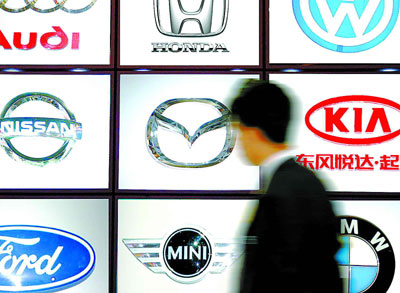
(Ecns.cn) -- Chinese automobile brands have largely operated on thin margins or have even suffered from losses since 2011, and many are now under pressure to make a retreat, reports the China Economic Weekly.
Following the market boom between 2009 and 2010, the market share of Chinese cars has continued to slip for over a year, while joint-stock brands and imported vehicles have enjoyed increased market momentum.
Industry watchers say domestic carmakers have used the wrong strategy from the very beginning, and that they must now move to a more sustainable growth pattern to compete with global rivals.
Feeling the pinch
Statistics show the market share of domestic car brands slipped for 15 months from 2011 to the first quarter of 2012.
Last year, Chinese branded vehicles took up 42.23 percent of the car market, down 3.37 percent on the year, while the market share of domestic passenger cars was only about 27 percent. The sales volume of homegrown car brands even saw a negative growth for four months.
In the first quarter of 2012, the downward trend continued, and most domestic brands experienced a significant sales decline. Chinese passenger car sales fell 8.1 percent from the previous year to 1.62 million vehicles during the first quarter.
Chery was down 23 percent while FAW, Chang'an, JAC, Zhonghua, Haima and Roewe were all down between 20 and 25 percent. Sales of BYD, a company based in Shenzhen, dropped 4 percent. Only Dongfeng Liuzhou and Dongfeng Passenger Vehicle (which were up 60 percent, but from a small base) and Great Wall and Geely (both flat for the first quarter) managed to escape the broad-based domestic brand downturn, according to China Daily.
It has been a dramatically different story for joint-stock brands and imported vehicles however. In the first ten months of 2011, Toyota sales increased 32.5 percent in China, Nissan was up 19.3 percent and Audi was up 32.1 percent. In the first three quarters of 2011, sales volume of BMW and its MINI model was up 45.7 percent in the Chinese mainland, while Mercedes-Benz was up 38 percent.
Independent auto analyst Jia Xinguang told the China Economic Weekly that there are many factors that caused the drop in sales of domestic brands, but that poor quality and brand image are the two fundamental weaknesses.
In the past, most people were buying their first cars, but now a significant percentage of them are upgrading, and homegrown brands cannot satisfy their demands, noted Jia.
There is an obvious gap between homegrown brands and international brands, Jia added, and domestic carmakers must not only make engineering improvements, but also shift their strategies to enhance their competitiveness.
Price war disadvantage
For many years, China's domestic brands have enjoyed some success because of their competitively low prices. But when they suddenly began to realize how important it is to focus on quality, technology and service, it was too little too late.
While they may be inexpensive, the unsatisfactory quality of Chinese cars has been a common complaint, although the average number of problems per domestic vehicle reported by consumers dropped from 8.34 in 2000 to 2.32 in 2011.
Yet higher quality comes with its own set of risks. Domestic carmakers such as Chery and Guangzhou Automobile have learned that the hard way after daring to venture into the mid- and high-end market in recent years.
The Trumpchi, Guangzhou Automobile's flagship sedan, went on sale in late 2010 for 180,000 yuan (US$28,571), 40,000 to 50,000 yuan cheaper than its major rivals, the Honda Accord and Toyota Camry.
However, the Trumpchi lost its cost advantage last year after prices of the Camry and Accord fell sharply to 150,000 yuan and 170,000 yuan respectively. Trumpchi dealers were forced to offer discounts in order to maximize sales.
Chery also had similar experiences in 2010 and 2011, but its latest attempt may prove more successful. This year Chery bought Hummer from General Motors, and plans to hit the mid- and high-end market by introducing joint-stock brands, which should rate higher in terms of quality and brand image.
Urgent task
Under great pressure, many domestic car brands have made a retreat from the market and realized the importance of engineering improvements as well as research and development.
On November 9, 2011, after a sharp decline in sales, BYD Board Chairman Wang Chuanfu admitted that his company had only focused on the number of dealers and the production of cars while neglecting many other details.
In the push for quantity over quality, many domestic brands have struggled with similar problems. One auto expert commented that a product cycle is normally five years, but many Chinese brands develop new products in only one year.
The good news is that more and more domestic auto companies have begun placing greater emphasis on research and development in recent years. Some have even established their own research centers based in China, although spending on R&D here is still far less than foreign carmakers.
This year, private car manufacturer JAC set up a quality guarantee alliance to boost quality, with 300 core component suppliers and more than 400 partners participating.
As Chinese drivers raise their standards, the auto industry must make deep changes in its development by shifting the focus from quantity and speed of production to quality and brand image, which will ultimately boost the reputation of Chinese-made automobiles.

Copyright ©1999-2011 Chinanews.com. All rights reserved.
Reproduction in whole or in part without permission is prohibited.